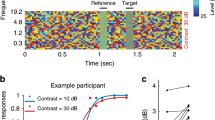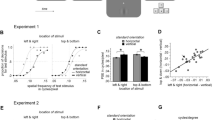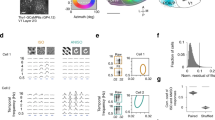Abstract
MACKAY1 has made use of the phenomenon of simultaneous contrast to provide evidence for the existence in the human visual system of neural channels that are sensitive to the density of visual texture. Using the same phenomenon, we have provided comparable evidence for the existence of lateral interaction between channels sensitive to velocity. That such channels do exist is suggested by the preliminary psychophysical observations of Pantle and Sekuler2, who demonstrated a luminance threshold elevation for moving contours that is limited to a range of values around the velocity of the adapting contour.
This is a preview of subscription content, access via your institution
Access options
Subscribe to this journal
Receive 51 print issues and online access
$199.00 per year
only $3.90 per issue
Buy this article
- Purchase on Springer Link
- Instant access to full article PDF
Prices may be subject to local taxes which are calculated during checkout
Similar content being viewed by others
References
MacKay, D. M., Nature, 245, 159–161 (1973).
Pantle, A. J., and Sekuler, R. W., Vision Res., 8, 445–450 (1968).
Grusser, O.-J., and Grusser-Cornehls, U., in The Handbook of Sensory Physiology, (edit. by Jung, R.), 3 a, 333–429 (Springer, Berlin-Heidelberg-New York, 1973).
Blakemore, C., and Tobin, E. A., Expl Brain Res., 15, 439–440 (1972).
Author information
Authors and Affiliations
Rights and permissions
About this article
Cite this article
WALKER, P., POWELL, D. Lateral interaction between neural channels sensitive to velocity in the human visual system. Nature 252, 732–733 (1974). https://doi.org/10.1038/252732a0
Received:
Issue Date:
DOI: https://doi.org/10.1038/252732a0
This article is cited by
-
Visual neuroscience research in China
Science China Life Sciences (2010)
-
A special class of nonlinear interactions in the visual system of the fly
Biological Cybernetics (1976)
Comments
By submitting a comment you agree to abide by our Terms and Community Guidelines. If you find something abusive or that does not comply with our terms or guidelines please flag it as inappropriate.



